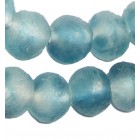There are so many different types of Recycled Glass Beads produced in Ghana today. From the fancy hand-painted Powder Glass Beads made to look like old Venetian Millefioris, to annular wound beads, similar to those shipped over from Europe in the 16th Century, there’s very little you can’t find in the markets at Adomanya and Koforidua. But, while the Akan ethnic groups of Ghana are considered artisans in their own right, there are some who employ cunning techniques to transform the appearance of plain old beads into something considered far more valuable: Aggrey Beads.
The origins of Aggrey Beads are still widely disputed, in part because the term “aggrey” also means “coral” in many Akan dialects. Historians believe the blue wound glass beads were named after the blue coral found in the waters off the Gold Coast, however, tribes such as the Fanti and Asante refer to this as “koli”, rather than aggrey. The term “koli” is also widely used to refer to beads which are light blue in color. The discovery of light blue dichroic beads by archaeologists in Cairo, Egypt, offers the most likely explanation for the origins of Aggrey Beads, and yields some clue as to why they’re so highly sought after.

Opaque Blue Recycled Glass Beads
Aggrey Beads produced in Ghana today look much like the worn dichroic beads of old – largely due to the bead cooking technique employed by market dealers and resellers. Translucent wound or pressed beads are placed together in a metal pot filled with water and organic matter. The beads are then cooked for up to an hour over a charcoal fire to alter their molecular structures. This causes bubbles to rise to the surface, and the outer skin of the bead becomes darker and more opaque. Imitation Aggrey Beads can be found in a wide spectrum of colors, and may also be called “koli” or “cori” beads by natives.